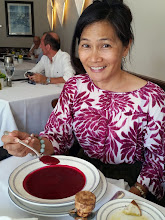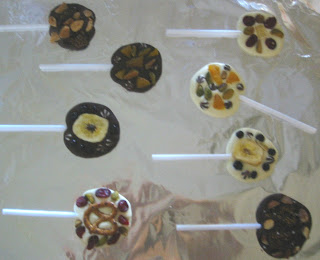The Saturday before Christmas, my friend Maya hosted her first
tamale-making party. As a child on up, she had helped out at gatherings of friends and family. But this year, she wanted to start a new tradition. I could not help but think about the first time I had made tamales with her.
Her
stepfather , a former state Assemblyman and founder and bishop of his church, had been extremely ill for months and was at home in between numerous hospital stays. Her mother, an energetic college administrator and nurturing mentor to many, was constantly busy taking care of her husband while keeping up with work at the office. We call her "Dr. Ruth," not in reference to the
diminutive sex therapist, but because of the authority she wielded over so many people's lives, lives that were willingly offered to her for advice, guidance, and support.
Yet, this busy and accomplished woman wanted to make tamales for Christmas. Maya invited me to their home in Long Beach so that I could finally experience this time-honored family tradition.
I arrived at their Long Beach home and was surprised and not a little touched to see Maya's stepdad installed in a hospital-type bed in a room off the kitchen. Dr. Ruth, who apparently had not really made tamales by herself before, asked a co-worker's mother to help prepare the spicy meat filling. The formidable Dr. Ruth had an apron tied over one of her typically professional "office" outfits. She would frequently leave Maya and I in the kitchen to check on her husband with great tenderness and solicitude.
Maya and I laughed over my beginner's "rank" on the tamale-making "totem pole." I was only fit to be a "spreader" at this point, and happily scraped masa onto cornhusks all afternoon. I marveled at the giant - I mean, giant - pot that was used to steam the tamales. The results were delicious and warming. But the months to come were not ones to celebrate.
 A basic tamale steamer is huge. Masa for the masses.
A basic tamale steamer is huge. Masa for the masses.Maya's stepdad - who she and her brother affectionately called
"Pop," died a couple of months later. I remember totally losing it at the funeral. I cried for Maya, who I had always envied for having not one, but two great dads. I cried for her mother, who handled the whole thing with her usual stoic grace. And I cried for myself, because I was only a few months into a marriage that would end that summer. I hated myself because I could not envision myself at that time, standing behind my new husband the way that Dr. Ruth had stood by hers.
Three years later, Maya decided to have her tamale party. It was at her Aunt Linda's house, and to be attended only by those serious about making tamales. As a matter of fact, she wanted it to be a "dry" party, unlike the ones that she described at the homes of family friends. But in the end, she relented and stocked up on
cervezas and some harder stuff.
 The secret ingredient. It's not chiles or onions - it's cojones. Photo by Maya Banda
The secret ingredient. It's not chiles or onions - it's cojones. Photo by Maya BandaStocking the bar was not the only preparation for Tamale Boot Camp, which took place on the Saturday before Christmas. On Wednesday, Maya started all the shopping, gathering the ingredients, including 40 pounds of
masa and two turkeys that she and her cousin roasted the next day. After roasting the turkeys, Maya set about finding the right degree of heat, armed with a trusty blender and handfuls of jalapenos. That morning, she was at
Amapola Market at 6 a.m., standing in the rain with scores of other would-be tamale chefs before it opened. Her convivial co-hostess, Aunt Linda, who I always remembered for her cheerful and bustling ways throughout the family's bereavement and her mother's subsequent stroke, which occurred months after her husband died, teasing Maya for getting her up at the crack of dawn on a Saturday to start scrubbing the bathtub so that they could start soaking the
hojas (cornhusk tamale wrappers).
 This isn't as bad as when Kramer decided to use his shower as a kitchen sink, is it? Photo by Maya Banda
This isn't as bad as when Kramer decided to use his shower as a kitchen sink, is it? Photo by Maya Banda"Making tamales at my Grandma Juanita’s house on Christmas Eve morning has been a traditional event since I was a kid," recalled Maya. "We lost track for awhile when she and my grandpa moved to Tucson, but it started up again when they moved back [here].
"The Gonzales Girls, my mom and her two sisters, would all go over to my grandma’s house and form the assembly line. A lot has changed in everyone’s lives in the past few years. The Gonzales Girls are never going to get together and make tamales the way [they] used to. As soon as I realized that, I also realized, this would be the perfect year to try something new. My grandma, mom, and aunts all taught me things over the years. Spending time in the kitchen with them taught me how to do things and how not to do things. I can’t let all that go to waste. Before I let a tradition die off, I wanted to start a new one. New people, new recipes, new atmosphere. Every time I participated in an assembly line was part of someone’s tradition - why not start one of my own?"

Tamale filling: turkey, green chiles, and memories.Music is a big part of Maya's life. Her dad is one half of the
Banda Brothers, the mastermind on the drums. He and his bassist brother Tony have played with everyone from Celia Cruz to Jackson Browne. She and I even had, for a brief time, a show on the university's Internet radio station. We dubbed ourselves "The Queen Bee and Danger Fox." Her Highness's groove was blues, R & B, and funk; mine was 80s, country, and a smattering of jazz and randomness. We gave our seven known listeners a taste of our combined eclecticism and the alter egos we hid beneath our (mostly) ladylike exteriors.
That being said, the perfect music for making tamales is
Etta James,
Vicente Fernandez, and Maya's all-time favorite band,
Tower of Power. This was the soundtrack as I arrived at Aunt Linda's, where preparations to begin the assembly line were under way. I jumped in and started to dry piles of hojas with Stephanie, a young friend of the family for whom Tamale Boot Camp was initiation by fire. Slowly but surely, the novice and I, an almost-novice, were promoted up the ranks of the tamale "ladder," going from lowly cornhusk driers to the coveted posts of spreaders and folders. Actually, Stephanie surpassed me more quickly and ended up with a more skilled task, that of wrapping the tamales in paper, labeling them as to their fillings, and packaging them as baker's dozens of 13 per Ziploc bag. At the home stretch of our tamale-making marathon, I realized my
OCD personality was best suited to drying hojas and went back to my original task.
 How dry I am: blotting hojas before wrapping tamales.
How dry I am: blotting hojas before wrapping tamales.Papa Ramon showed up and was put to work as a spreader. We laughed as Maya expressed her approval of her father's efforts at spreading masa - and proceeded to redo his hojas. We sampled some tamales that Aunt Linda had received from friends and neighbors, the most
picoso being some cheese tamales made with masa dyed green from an abundance of chiles.

Maya and her dad. The apple of "cool" doesn't fall far from the tree!When one of the tables in the kitchen was almost covered with bulging plastic bags, Maya put several dozen into the two-foot high tamale steamer. She had to climb on a small stepladder to reach into the pot. It takes several hours to steam that many tamales, so we didn't sample them that evening.
But a couple of days later, she brought me a freezer bag and a couple of cooked turkey tamales, so my first taste of Los Tamales de la
Abeja Reina was at my desk. They were spicy, but not highly so, and the masa turned out tender and flavorful, due to our careful spreading techniques: the hard waxy exteriors that often occur are a result of laying the masa on like plaster. Less is definitely more.

When spreading masa, thin is in.What Maya remembers most about making tamales as a little girl is "looking forward to seeing improvement in my skills and developing my techniques. Sounds silly I know. I was all about being a 'master-spreader' wanting to perfect the art of spreading masa. I used to look forward to getting approval from the elders. She put this into practice at a more recent tamale party.
"Things had always been pretty straightforward and traditional until last year I went to a tamale making party for a family friend," she recalls. "Lots of people, lots of meat, and New Mexico chile. There must have been at least 30 people. Folks were drinking, playing music, laughing - not like grandma’s house with just the four or five of us. I was offered a drink and I didn’t want one - me, refuse a drink! It just didn’t seem right to drink and make tamales at the same time.
"We were outside under the patio sitting at tables," Maya says. "I picked up a spoon and started spreading [masa]. A friend said, 'Wow, Maya’s doing it like my grandma used to.' Some folks were spreading the masa like butter on bread with rubber spatulas. It was all over the table! But everyone was having a great time."
In the spirit of the Christmas (that's right, score one for the Judeo-Christian tradition!) season, the thing Maya likes best about tamales is "Giving them away."
 Virtual hug while in the trenches at work: Maya's tamales are a reminder of friends, family, and the holidays.
Virtual hug while in the trenches at work: Maya's tamales are a reminder of friends, family, and the holidays.A hearty
gracias to the Queen Bee, her beautiful family, and an old/new holiday tradition that I'm grateful to add to my list.





























